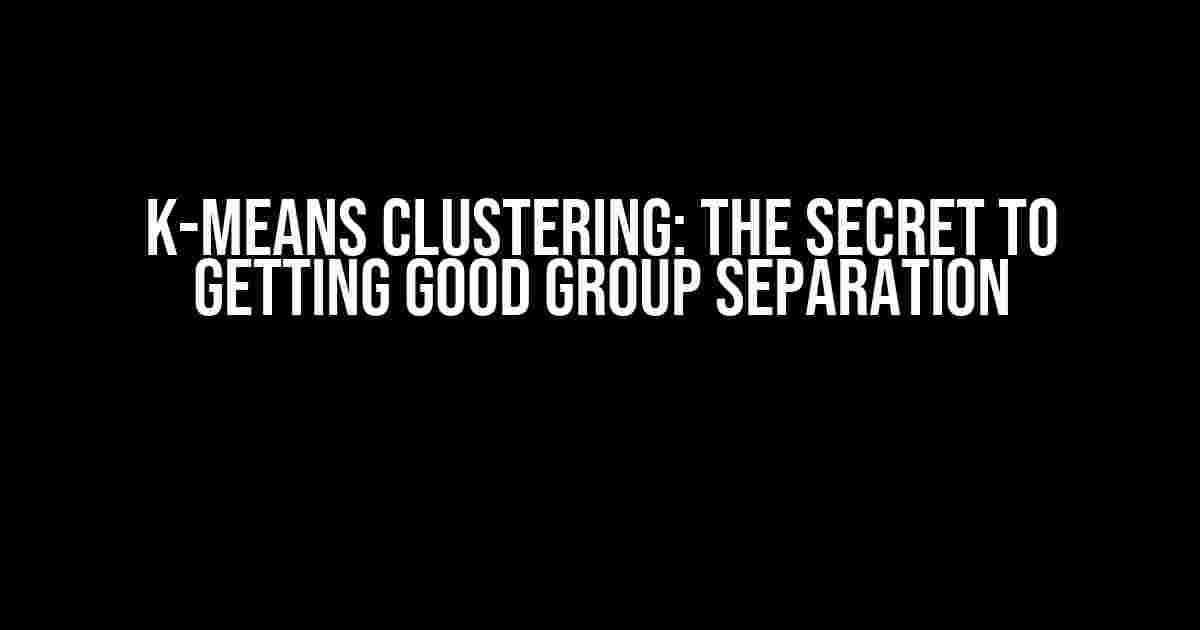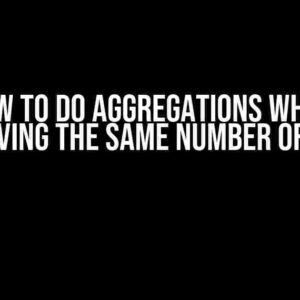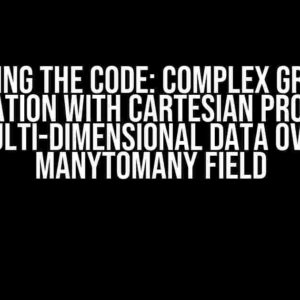Introduction
K-Means clustering is a powerful unsupervised machine learning algorithm that helps you divide your data into distinct groups based on their similarities. But, getting good group separation is not always a walk in the park. It requires a combination of the right techniques, parameters, and understanding of the data. In this article, we’ll dive deep into the world of K-Means clustering and explore the secrets to achieving good group separation.
Understanding K-Means Clustering
Before we dive into the nitty-gritty of getting good group separation, let’s quickly recap what K-Means clustering is all about. K-Means is an unsupervised machine learning algorithm that groups similar data points into clusters based on their features. The algorithm works by iteratively updating the centroid of each cluster and reassigning data points to the cluster with the closest centroid.
K-Means Algorithm: 1. Initialize centroids (K) randomly 2. Assign each data point to the closest centroid 3. Update the centroid of each cluster by calculating the mean of all data points assigned to it 4. Repeat steps 2-3 until convergence or maximum iterations reached
Challenges of Getting Good Group Separation
Despite its simplicity, K-Means clustering can be challenging to get right, especially when it comes to achieving good group separation. Here are some common challenges you might face:
- Choosing the right number of clusters (K): If you choose too few clusters, you might end up with low-quality clusters. If you choose too many, you might end up with overly complex clusters that don’t make sense.
- Dealing with noisy or outliers data: Noisy or outlier data points can affect the quality of your clusters, making it difficult to achieve good group separation.
- Handling high-dimensional data: As the number of features increases, it becomes more challenging to visualize and analyze the data, making it harder to get good group separation.
- Selecting the right distance metric: The choice of distance metric can significantly impact the quality of your clusters. Different distance metrics can lead to different clustering results.
Techniques for Achieving Good Group Separation
Now that we’ve discussed the challenges, let’s explore some techniques to help you achieve good group separation using K-Means clustering:
1. Data Preprocessing
Data preprocessing is an essential step in any machine learning algorithm. For K-Means clustering, you should:
- Handle missing values
- Normalize or scale your data
- Remove noise or outliers (if possible)
- Transform categorical variables into numerical variables (if necessary)
Example code: from sklearn.preprocessing import StandardScaler scaler = StandardScaler() X_scaled = scaler.fit_transform(X)
2. Feature Selection
Feature selection can help reduce the dimensionality of your data, making it easier to visualize and analyze. You can use:
- Correlation analysis to select relevant features
- Recursive feature elimination (RFE) to recursively eliminate features
- Principal component analysis (PCA) to reduce dimensionality
Example code: from sklearn.feature_selection import SelectKBest selector = SelectKBest(k=5) X_selected = selector.fit_transform(X, y)
3. Choosing the Right Distance Metric
The choice of distance metric can significantly impact the quality of your clusters. You can use:
- Euclidean distance (default)
- Manhattan distance (L1)
- Cosine similarity
- Kullback-Leibler divergence
Example code: from sklearn.cluster import KMeans kmeans = KMeans(n_clusters=5, metric='cosine') kmeans.fit(X)
4. Selecting the Right Number of Clusters (K)
Choosing the right number of clusters can be challenging. You can use:
- Elbow method to visualize the distortion curve
- Silhouette analysis to evaluate cluster cohesion and separation
- Gap statistic to estimate the optimal number of clusters
Example code: from sklearn.cluster import KMeans from sklearn.datasets import make_blobs X, y = make_blobs(n_samples=200, n_features=2, centers=5, random_state=0) kmeans = KMeans(n_clusters=5) kmeans.fit(X) print(kmeans.inertia_) # distortion curve
Additional Tips for Achieving Good Group Separation
In addition to the techniques mentioned above, here are some additional tips to help you achieve good group separation:
- Use visualization tools: Visualization can help you understand the structure of your data and identify potential clusters.
- Experiment with different algorithms: K-Means is not the only clustering algorithm. Experiment with other algorithms like Hierarchical Clustering or DBSCAN to see which one works best for your data.
- Don’t over-cluster: Be careful not to over-cluster your data, as this can lead to low-quality clusters.
- Use domain knowledge: If you have domain knowledge about the data, use it to inform your clustering approach.
Conclusion
Achieving good group separation using K-Means clustering requires a combination of the right techniques, parameters, and understanding of the data. By following the tips and techniques outlined in this article, you can improve the quality of your clusters and get better insights from your data. Remember to always experiment, visualize, and iterate to achieve the best results.
| Technique | Description |
|---|---|
| Data Preprocessing | Handle missing values, normalize/scal |
| Feature Selection | Select relevant features using correlation analysis, RFE, or PCA |
| Distance Metric | Choose the right distance metric (Euclidean, Manhattan, Cosine, Kullback-Leibler) |
| Number of Clusters (K) | Use elbow method, silhouette analysis, or gap statistic to estimate K |
By mastering these techniques, you’ll be well on your way to achieving good group separation using K-Means clustering. Happy clustering!
Frequently Asked Question
Get ready to unlock the secrets of K-means clustering and achieve optimal group separation!
What is the magic behind K-means clustering that leads to good group separation?
The magic lies in the way K-means clustering works! It’s a type of unsupervised machine learning algorithm that groups similar data points into clusters based on their features. The algorithm iteratively updates the centroid of each cluster and reassigns data points to the cluster with the closest centroid, resulting in well-separated groups.
How do I choose the optimal number of clusters (K) for good group separation?
Choosing the right number of clusters is crucial! A common approach is to use the Elbow method, which involves plotting the within-cluster sum of squares against the number of clusters. The point where the curve starts to flatten out indicates the optimal number of clusters. You can also use techniques like Silhouette analysis or Gap statistic to determine the best value of K.
How does feature scaling affect K-means clustering and group separation?
Feature scaling is essential! If features have different scales, it can lead to biased clustering results. Scaling features to a common range (e.g., between 0 and 1) helps to prevent domination by features with large ranges, ensuring that all features contribute equally to the clustering process and resulting in better group separation.
Can K-means clustering handle noisy or outlier data, and how does it affect group separation?
K-means clustering can be sensitive to noisy or outlier data. To minimize the impact, you can use techniques like data preprocessing (e.g., normalization, feature selection), outlier detection, or robust K-means algorithms that can handle noisy data. These strategies can improve the robustness of the clustering results and lead to better group separation.
How do I evaluate the quality of K-means clustering and group separation?
Evaluating the quality of K-means clustering is crucial! You can use metrics like Silhouette score, Calinski-Harabasz index, or Davies-Bouldin index to assess the quality of the clustering results. These metrics provide insights into the separation, cohesion, and density of the clusters, helping you to refine your clustering model and achieve optimal group separation.



